Walker J. Facies models, Canada, 1992
Подождите немного. Документ загружается.

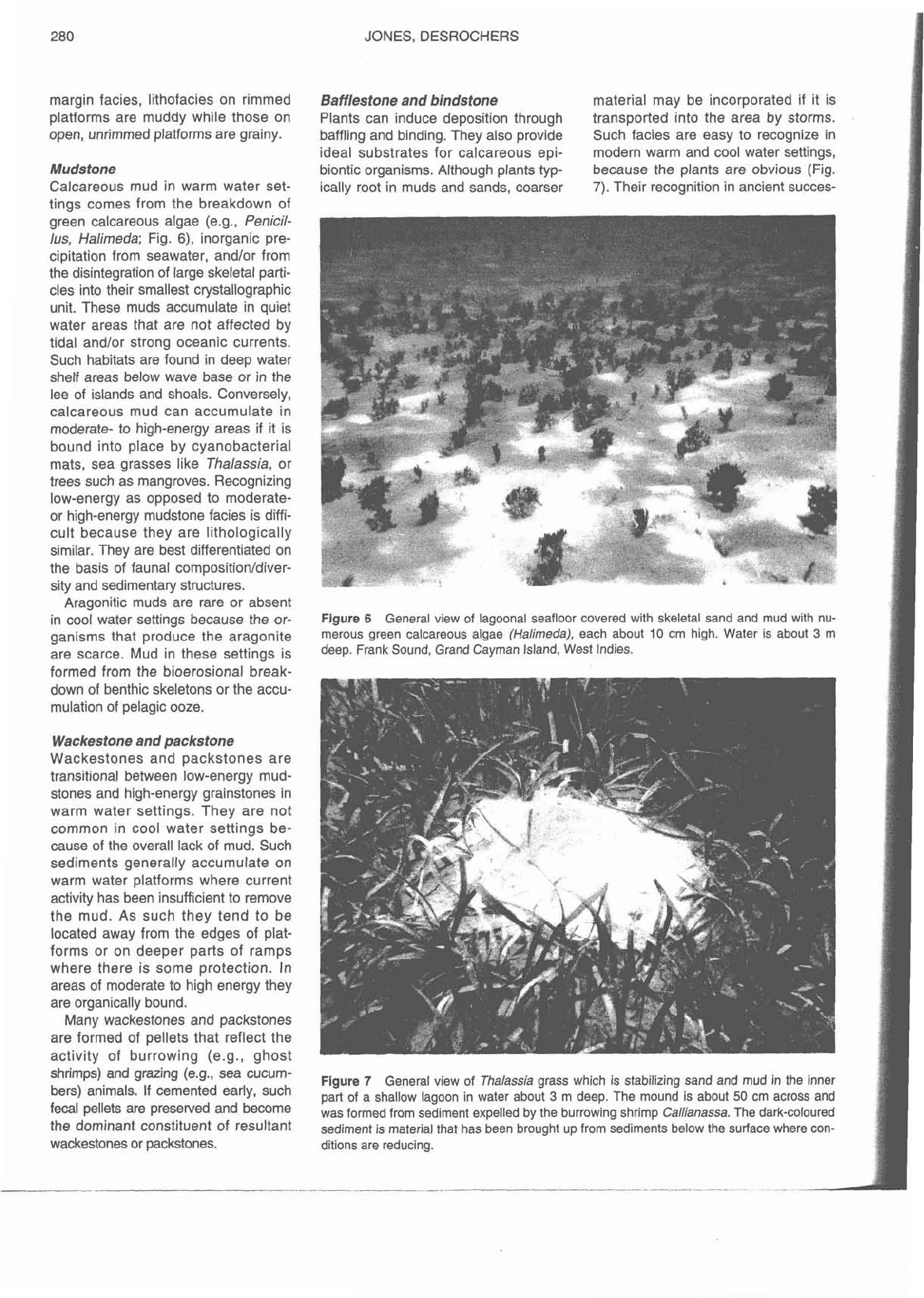
280
JONES, DESROCHERS
margin facies, lithofacies on rimmed
Bafflestone and bindstone
material may be incorporated if it is
platforms are muddy while those on
Plants can induce deposition through
transported into the area by storms.
open, unrimmed platforms are grainy.
baffling and binding. They also provide
Such facies are easy to recognize in
ideal substrates for calcareous epi-
modern warm and cool water settings,
Mudstone
biontic organisms. Although plants typ-
because the plants are obvious (Fig.
Calcareous mud in warm water set-
ically root in muds and sands, coarser
7).
Their recognition in ancient succes-
tinas comes from the breakdown of
"
green calcareous algae (e.g., Penicil-
/us, Halimeda; Fig.
6),
inorganic pre-
cipitation from seawater,
and/or from
the disintegration of large skeletal parti-
cles into their smallest crystallographic
unit. These muds accumulate in quiet
water areas that are not affected by
tidal
and/or strong oceanic currents.
Such habitats are found in deep water
shelf areas below wave base or in the
lee of islands and shoals. Conversely,
calcareous mud can accumulate in
moderate- to high-energy areas if it is
bound into place by cyanobacterial
mats, sea grasses like
Thalassia, or
trees such as mangroves. Recognizing
low-energy as opposed to
moderate-
or high-energy mudstone facies
is
diffi-
cult because they are lithologically
similar. They are best differentiated on
the basis of faunal
composition/diver-
sity and sedimentary structures.
~ra~onitic muds-are rare or absent
in cool water settings because the
or-
Figure
6
General view of lagoonal seafloor covered with skeletal sand and mud with nu-
ganisms that produce the aragonite
merous green calcareous algae (Halimeda), each about
10
cm high. Water is about
3
m
are scarce. ~~d
in
these settings
is
deep. Frank Sound, Grand Cayman Island, West Indies.
formed from the bioerosional break-
down of benthic skeletons or the accu-
mulation of pelagic ooze.
Wackestone and packstone
Wackestones and packstones are
transitional between low-energy
mud-
stones and high-energy grainstones in
warm water settings. They are not
common in cool water settings be-
cause of the overall lack of mud. Such
sediments generally accumulate on
warm water platforms where current
activity has been insufficient to remove
the mud. As such they tend to be
located away from the edges of plat-
forms or on deeper parts of ramps
where there is some protection. In
areas of moderate to high energy they
are organically bound.
Many wackestones and packstones
are formed of pellets that reflect the
activity of burrowing
(e.g., ghost
shrimps)
and
grazing
(e'g''
sea
cucum-
Figure
7
General view of Thalassia grass which is stabilizing sand and mud in the inner
hers)
animals'
If
cemented
early*
such
part of a shallow lagoon in water about
3
m deep. The mound is about
50
cm across and
fecal
pellets
are
preselved
and become
was formed from sediment expelled by the burrowing shrimp Callianassa. The dark-coloured
the dominant constituent of resultant
sediment is material that has been brought up from sediments below the surface where con-
wackestones or packstones.
ditions are reducing.

-
--
15.
PLATFORM CARBONATES
$ions is difficult because the organic
lissue of plants is lost following their
rapid decay. Examples of fossilized
Thalassia
grass and/or mangrove roots
are the exception rather than the rule.
Poor sorting of sediment, or the presence
d
identifiable mound-like structures may
provide some clues. Knowledge of the
associated
fauna/flora, however, may
be
the best evidence because some taxa
are known to be specific to
seagrass
meadows or mangroves. Gastropods and
foraminifera are particularly useful
because certain forms live only on grass
blades or submerged tree roots (Jones
and Hunter, 1990).
Bindstones produced through the trap-
ping action of algal mats may be easier to
recognize because they are generally
laminated. Conversely, burrowing
organ-
Figure
8
General view of shelf sands in
5
m of water that have been extensively biotur-
bated by burrowing shrimp
(Callianassa).
Such burrowing activity will homogenize the sedi-
ment and completely destroy other original sedimentary structures. Hammer handle is
20
cm
long.
Figure
9
Boulders from a rimming reef prograding over lagoonal sands. Most clasts are
coral heads that are transported during storms. Large clasts in the foreground are
50
cm in
diameter. East Sound, Grand Cayman Island.
isms
(e.g., shrimp, crabs; Fig. 8) may
remove all trace of such laminations as
they homogenize the sediment.
Grainstone and rudstone
Grainstones in cool water settings are
well-washed skeletal sands derived
from bryozoa, molluscs, brachiopods,
and foraminifera. Further information
on the depositional setting of such
grainstones can be deduced from the
bioclasts. Skeletal morphology has
been used to define environmentally
sensitive subfacies in the widespread
bryozoa-rich facies that characterize
cool water platforms (Nelson
et
a/.,
1988; James and Bone, 1991).
Warm water grainstones, formed
of bioclasts, ooids,
and/or peloids,
usually occur in high-energy areas,
such as shoals and beaches. In some
cases high-energy conditions are con-
stant
(e.g., tides and/or oceanic waves
and currents). In other instances the
environments are only periodically
subjected to storm-induced
high-
energy conditions which remove the
mud but leave coarser-grained sedi-
ment behind. Haloes of gravels and
boulder-rich sediments (rudstones) are
common around patch reefs or behind
barrier reefs (Figs. 9, 10). Such sedi-
ment may be generated catastrophi-
cally during storms or through the
everyday breakdown of the reefs by
bioerosion.
Storm
deposlts
Storms can quickly and radically alter
sediment distribution on any part of the
platform that is above storm wave base.
Although their effect on shallow water
carbonates is the most obvious it must
be remembered that the base of
stom-
generated waves may reach tremen-
dous depths. Nelson
et
a/.
(1 982) noted
that storm waves produced current ve-
locities of up to 11
cmlsec at depths
down to
100
m on the Three Kings
Plateau, northern New
Zealand.
Storm waves and currents cause ex-
tensive remobilization of sediments and
basinward transport of sands and
muds. This leaves beds of
grainstone-
packstone with distinctive sedimentary
structures that will be interbedded with
the fairweather, bioturbated
wacke-
stone-mudstone (Figs. 11, 12). Hum-
mocky cross-stratified grainstone and
graded grainstone-packstone are two
types of tempestite that commonly form
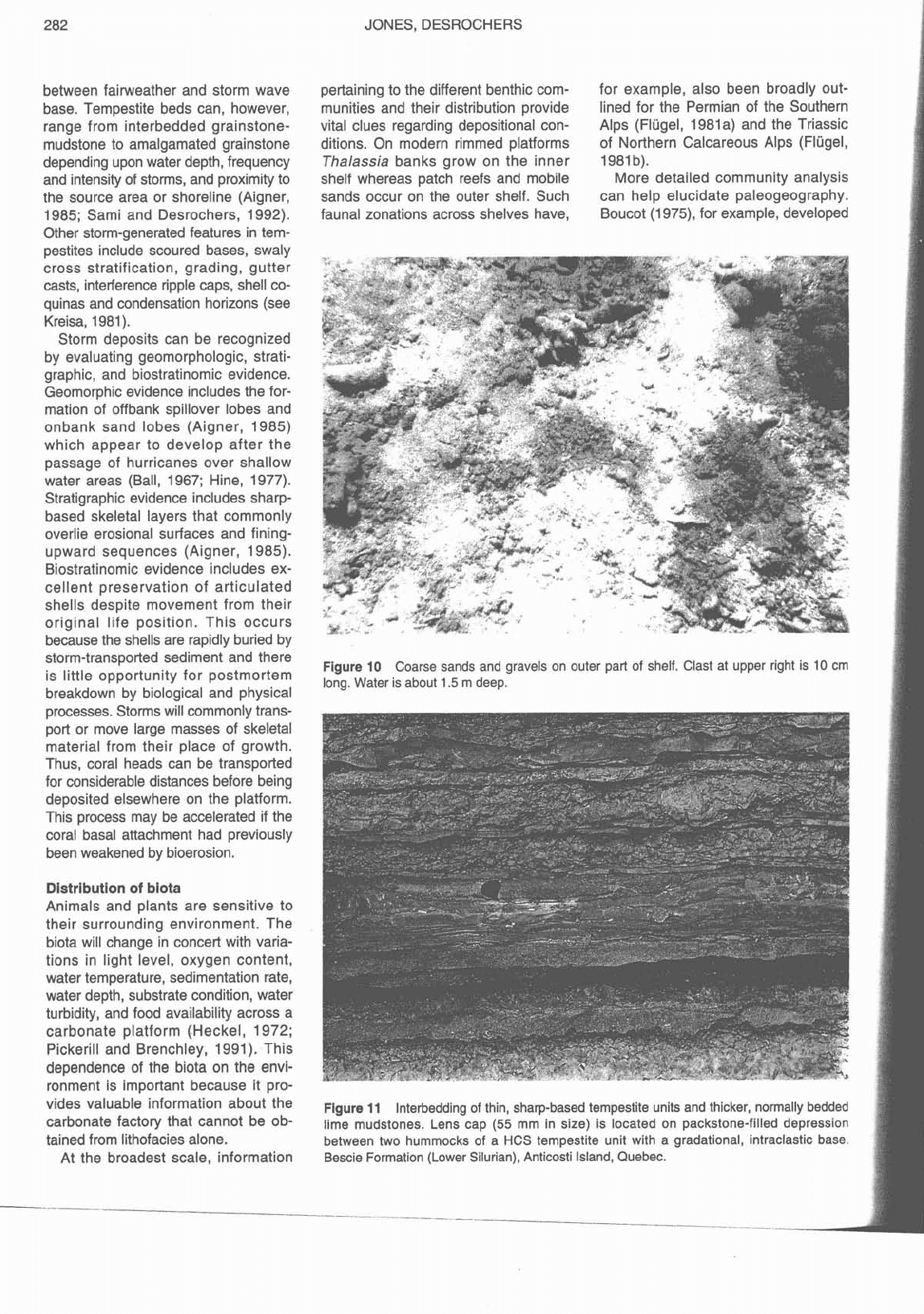
282 JONES, DESROCHERS
between fairweather and storm wave
base. Tempestite beds can, however,
range from interbedded
grainstone-
mudstone to amalgamated grainstone
depending upon water depth, frequency
and intensity of storms, and proximity to
the source area or shoreline (Aigner,
1985; Sami and Desrochers, 1992).
Other storm-generated features in
tem-
pestites include scoured bases, swaly
cross stratification, grading, gutter
casts, interference ripple caps, shell
co-
quinas and condensation horizons (see
Kreisa, 1981).
Storm deposits can be recognized
by evaluating geomorphologic, strati-
graphic, and biostratinomic evidence.
Geomorphic evidence includes the for-
mation of
offbank spillover lobes and
onbank sand lobes (Aigner, 1985)
which appear to develop after the
passage of hurricanes over shallow
water areas (Ball, 1967; Hine, 1977).
Stratigraphic evidence includes
sharp-
based skeletal layers that commonly
overlie erosional surfaces and
fining-
upward sequences (Aigner, 1985).
Biostratinomic evidence includes ex-
cellent preservation of articulated
shells despite movement from their
original life position. This occurs
because the shells are rapidly buried by
storm-transported sediment and there
is little opportunity for postmortem
breakdown by biological and physical
processes. Storms will commonly trans-
port or move large masses of skeletal
material from their place of growth.
Thus, coral heads can be transported
for considerable distances before being
deposited elsewhere on the platform.
This process may be accelerated if the
coral basal attachment had previously
been weakened by bioerosion.
Distribution
of
biota
Animals and plants are sensitive to
their surrounding environment. The
biota will change in concert with varia-
tions in light level, oxygen content,
water temperature, sedimentation rate,
water depth, substrate condition, water
turbidity, and food availability across a
carbonate platform
(Heckel, 1972;
Pickerill and Brenchley, 1991). This
dependence of the biota on the envi-
ronment is important because it
pro-
pertaining to the different benthic com-
munities and their distribution provide
vital clues regarding depositional con-
ditions. On modern rimmed platforms
Thalassia
banks grow on the inner
shelf whereas patch reefs and mobile
sands occur on the outer shelf. Such
faunal zonations across shelves have,
for example, also been broadly out-
lined for the Permian of the Southern
Alps
(Flugel, 1981a) and the Triassic
of Northern Calcareous Alps
(Flugel,
1981 b).
More detailed community analysis
can help elucidate paleogeography.
Boucot (1
975), for example, developed
Figure
10
Coarse sands and gravels on outer part of shelf. Ciast at upper right is
10
cm
long. Water is about
1.5
m
deep.
valuable
the
Figure
11
lnterbedding of thin, sharp-based tempestite units and thicker, normally bedded
carbonate factory that Cannot be ob-
lime mudstones. Lens cap
(55
mm in size) is located on packstone-filled depression
tained from lithofacies
alone.
between two hummocks of a HCS tempestite unit with a gradational, intraclastic base.
At the broadest scale, information
Bescie Formation (Lower Silurian), Anticosti Island, Quebec.
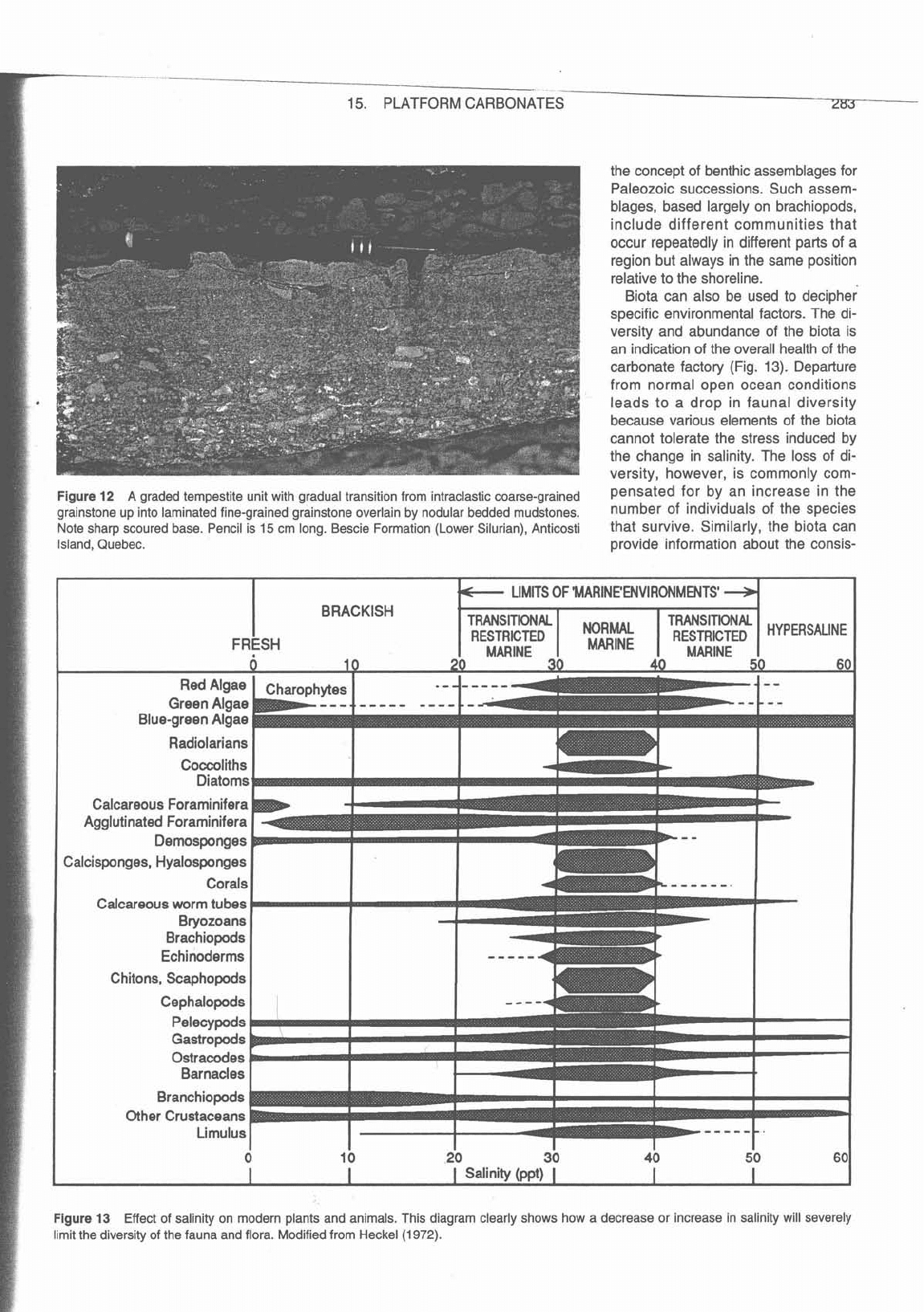
15.
PLATFORM CARBONATES
Figure
12
A graded tempestite unit with gradual transition from intraclastic coarse-grained
pensated by
an
increase
in
the
grainstone up into laminated fine-grained grainstone overlain by nodular bedded mudstones.
number of individuals of the species
Note sharp scoured base. Pencil is
15
cm long. Bescie Formation (Lower Silurian), Anticosti
that survive. Similarly, the biota Can
Island, Quebec. provide information about the consis-
Calcareous Foraminifera
Agglutinated Foraminifera
Calcisponges,
Hyalosponges
Calcareous worm tubes
Figure
13
Effect of salinity on modern plants and animals. This diagram clearly shows how a decrease or increase in salinity will severely
limit the diversity of the fauna and flora. Modified from
Heckel
(1972).
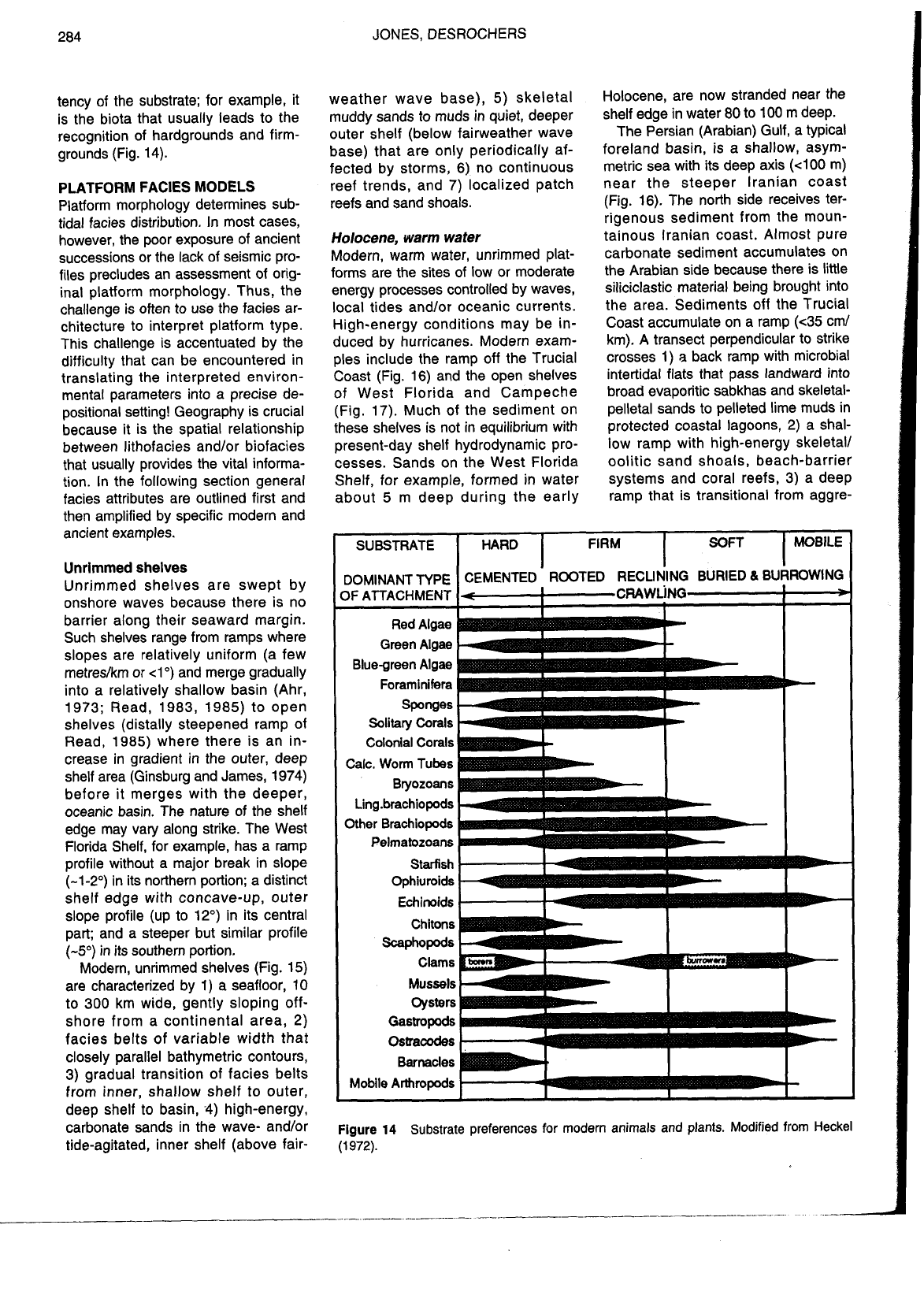
JONES, DESROCHERS
tency of the substrate; for example, it
is the biota that usually leads to the
recognition of hardgrounds and
firm-
grounds (Fig. 14).
PLATFORM FACIES MODELS
Platform morphology determines sub-
tidal facies distribution. In most cases,
however, the poor exposure of ancient
successions or the lack of seismic pro-
files precludes an assessment of orig-
inal platform morphology. Thus, the
challenge is often to use the facies ar-
chitecture to interpret platform type.
This challenge is accentuated by the
difficulty that can be encountered in
translating the interpreted environ-
mental parameters into a precise de-
positional setting! Geography is crucial
because it is the spatial relationship
between lithofacies and/or biofacies
that usually provides the vital informa-
tion. In the following section general
facies attributes are outlined first and
then amplified by specific modern and
ancient examples.
Unrimmed shelves
Unrimmed shelves are swept by
onshore waves because there is no
barrier along their seaward margin.
Such shelves range from ramps where
slopes are relatively uniform (a few
metreslkm or <I0) and merge gradually
into a relatively shallow basin (Ahr,
1973; Read, 1983, 1985) to open
shelves (distally steepened ramp of
Read, 1985) where there is an in-
crease in gradient in the outer, deep
shelf area (Ginsburg and James, 1974)
before it merges with the deeper,
oceanic basin. The nature of the shelf
edge may vary along strike. The West
Florida Shelf, for example, has a ramp
profile without a major break in slope
(-1-2") in its northern portion; a distinct
shelf edge with concave-up, outer
slope profile (up to 12") in its central
part; and a steeper but similar profile
(-5") in its southern portion.
Modern, unrimmed shelves (Fig. 15)
are characterized by
1)
a seafloor, 10
to 300 km wide, gently sloping off-
shore from a continental area,
2)
facies belts
of
variable width that
closely parallel bathymetric contours,
3) gradual transition of facies belts
from inner, shallow shelf to outer,
deep shelf to basin,
-4)
high-energy,
carbonate sands in the wave-
andlor
tide-agitated, inner shelf (above fair-
weather wave base), 5) skeletal
muddy sands to muds in quiet, deeper
outer shelf (below fairweather wave
base) that are only periodically af-
fected by storms, 6) no continuous
reef trends, and 7) localized patch
reefs and sand shoals.
Holocene, warm water
Modern, warm water, unrimmed plat-
forms are the sites of low or moderate
energy processes controlled by waves,
local tides
and/or oceanic currents.
High-energy conditions may be in-
duced by hurricanes. Modern exam-
ples include the ramp off the Trucial
Coast (Fig. 16) and the open shelves
of West Florida and Campeche
(Fig. 17). Much of the sediment on
these shelves is not in equilibrium with
present-day shelf hydrodynamic pro-
cesses. Sands on the West Florida
Shelf, for example, formed in water
about 5 m deep during the early
Holocene, are now stranded near the
shelf edge in water 80 to 100 m deep.
The Persian (Arabian) Gulf, a typical
foreland basin, is a shallow, asym-
metric sea with its deep axis
(400 m)
near the steeper Iranian coast
(Fig. 16). The north side receives
ter-
rigenous sediment from the moun-
tainous lranian coast. Almost pure
carbonate sediment accumulates on
the Arabian side because there is little
siliciclastic material being brought into
the area. Sediments off the Trucial
Coast accumulate on a ramp
(c35 cm/
km). A transect perpendicular to strike
crosses
1)
a
back ramp with microbial
intertidal flats that pass landward into
broad evaporitic sabkhas and
skeletal-
pelletal sands to pelleted lime muds in
protected coastal lagoons, 2) a shal-
low ramp with high-energy
skeletal/
oolitic sand shoals, beach-barrier
systems and coral reefs, 3) a deep
ramp that is transitional from
aggre-
OMINANT
TYPE
Colonial Corals
Calc. Worm Tubes
Other Brachiopods
Pelmatozoans
Figure
14
Substrate preferences for modern animals and plants. Modified from Heckel
(1
972).
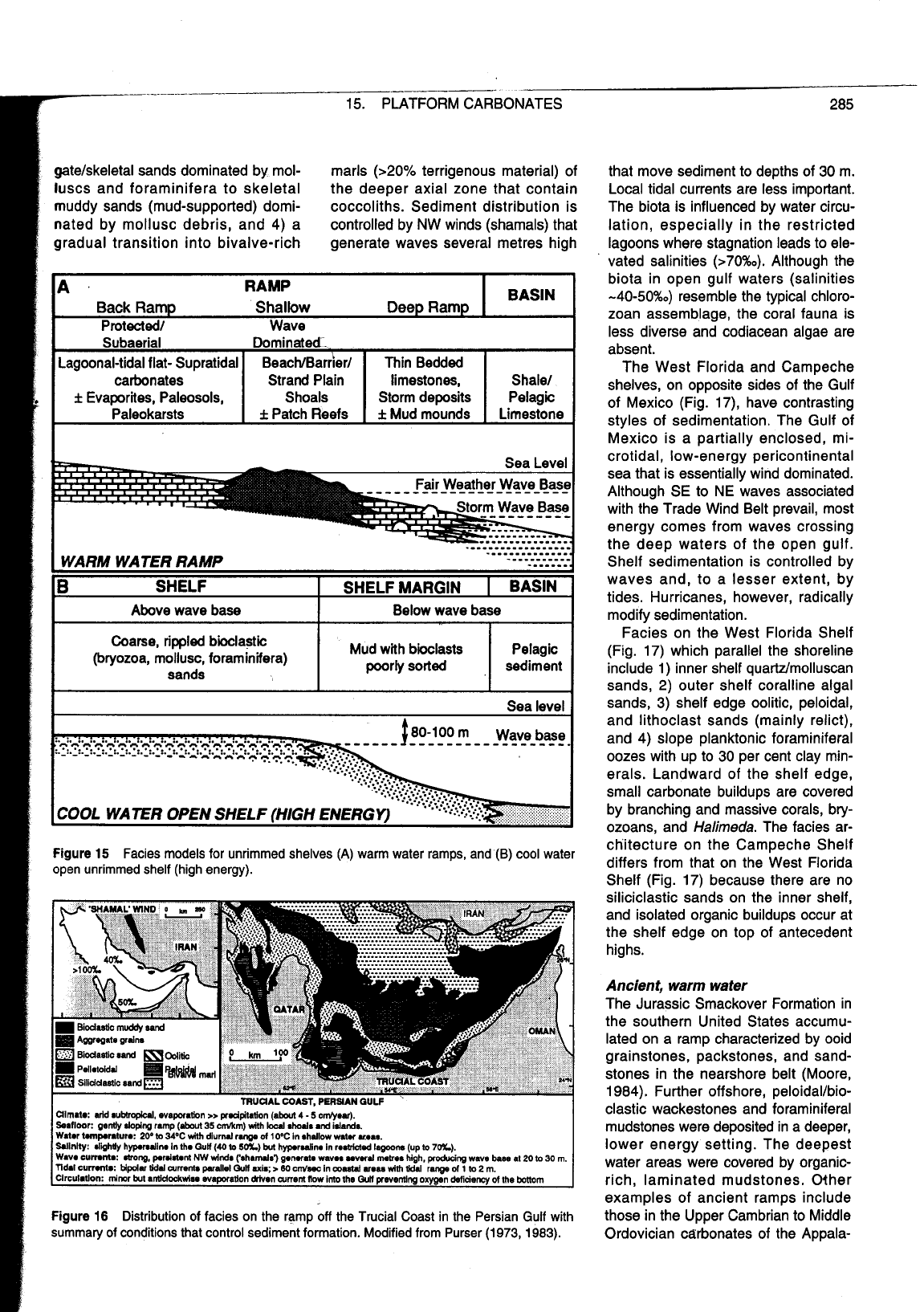
gatelskeletal sands dominated by mol- marls (>20% terrigenous material) of
luscs and foraminifera to skeletal
the deeper axial zone that contain
muddy sands (mud-supported)
domi-
coccoliths. Sediment distribution is
nated by mollusc debris, and 4) a
controlled by NW winds (shamals) that
gradual transition into bivalve-rich generate waves several metres high
torm
Wave
Base
Figure
15
Facies models for unrimmed shelves
(A)
warm water ramps, and
(B)
cool water
open unrimmed shelf (high energy).
Figure
16
Distribution
of
facies on the ramp off the Trucial Coast in the Persian Gulf with
summary of conditions that control sediment formation. Modified from Purser
(1973,
1983).
that move sediment to depths of
30
m.
Local tidal currents are less important.
The biota is influenced by water circu-
lation, especially in the restricted
lagoons where stagnation leads to ele-
vated salinities
(>70%0). Although the
biota in open gulf waters (salinities
-40-50%0) resemble the typical chloro-
zoan assemblage, the coral fauna is
less diverse and codiacean algae are
absent.
The West Florida and Campeche
shelves, on opposite sides of the Gulf
of Mexico (Fig.
17), have contrasting
styles of sedimentation. The Gulf of
Mexico is a partially enclosed,
mi-
crotidal, low-energy pericontinental
sea that is essentially wind dominated.
Although SE to NE waves associated
with the Trade Wind Belt prevail, most
energy comes from waves crossing
the deep waters of the open gulf.
Shelf sedimentation is controlled by
waves and, to
a
lesser extent, by
tides. Hurricanes, however, radically
modify sedimentation.
Facies on the West Florida Shelf
(Fig. 17) which parallel the shoreline
include 1) inner shelf
quartz/molluscan
sands,
2)
outer shelf coralline algal
sands,
3)
shelf edge oolitic, peloidal,
and lithoclast sands (mainly relict),
and
4)
slope planktonic foraminiferal
oozes with up to
30
per cent clay min-
erals. Landward of the shelf edge,
small carbonate buildups are covered
by branching and massive corals,
bry-
ozoans, and
Halimeda.
The facies ar-
ctiitecture on the Campeche Shelf
differs from that on the West Florida
Shelf (Fig. 17) because there are no
siliciclastic sands on the inner shelf,
and isolated organic buildups occur at
the shelf edge on top of antecedent
highs.
Ancient, warm water
The Jurassic Smackover Formation in
the southern United States accumu-
lated on a ramp characterized by ooid
grainstones, packstones, and sand-
stones in the nearshore belt (Moore,
1984). Further offshore,
peloidallbio-
clastic wackestones and foraminiferal
mudstones were deposited in a deeper,
lower energy setting. The deepest
water areas were covered by
organic-
rich, laminated mudstones. Other
examples of ancient ramps include
those in the Upper Cambrian to Middle
Ordovician carbonates of the
Appala-
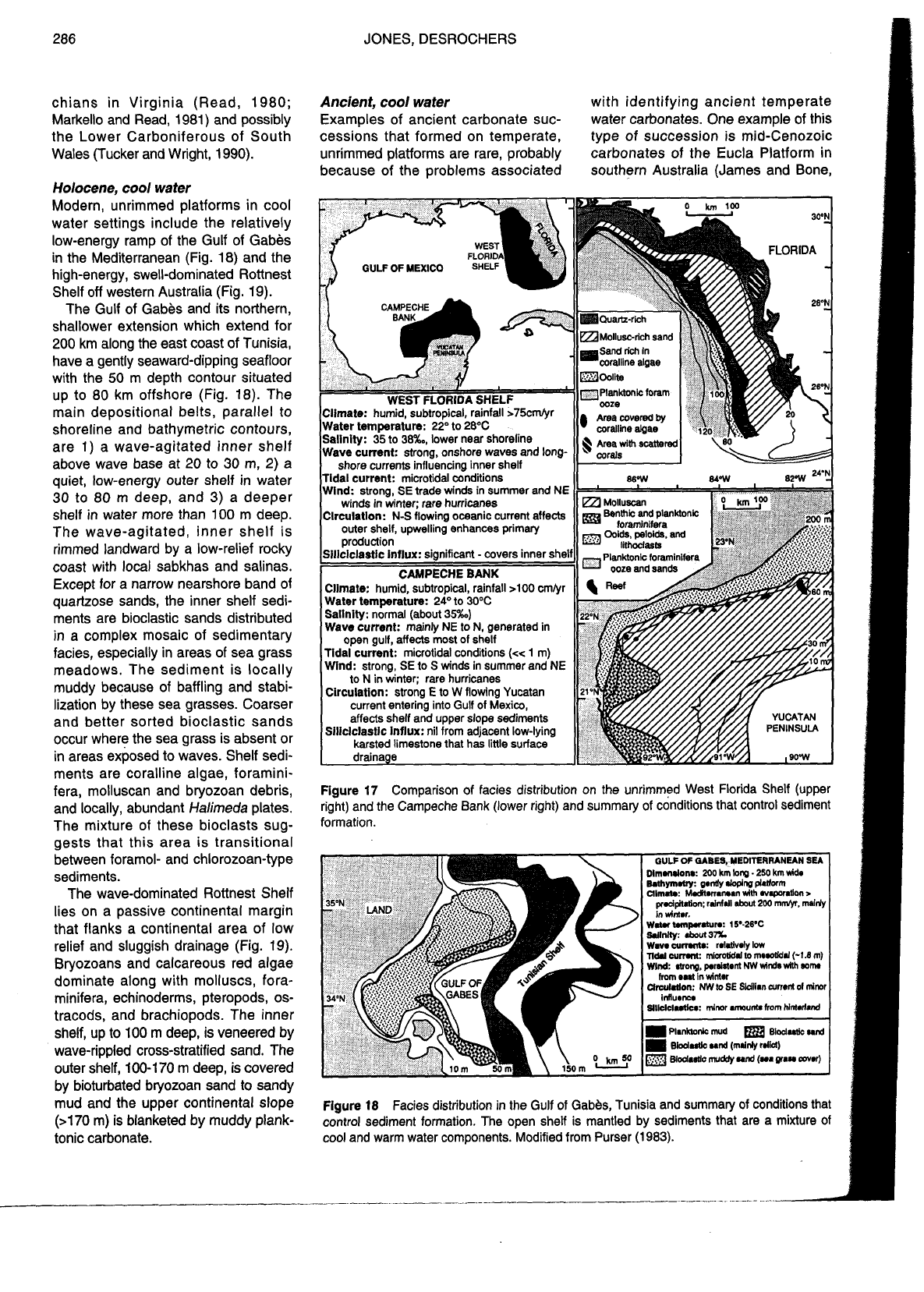
JONES, DESROCHERS
chians in Virginia (Read,
1980;
Markello and Read,
1981)
and possibly
the Lower Carboniferous of South
Wales (Tucker and Wright,
1990).
Holocene, cool water
Modern, unrimmed platforms in cool
water settings include the relatively
low-energy ramp of the Gulf of Gabes
in the Mediterranean (Fig.
18)
and the
high-energy, swell-dominated Rottnest
Shelf off western Australia (Fig.
19).
The Gulf of Gabes and its northern,
shallower extension which extend for
200
km along the east coast of Tunisia,
have a gently seaward-dipping
seafloor
with the
50
m depth contour situated
up to
80
km offshore (Fig.
18).
The
main depositional belts, parallel to
shoreline and bathymetric contours,
are
1)
a wave-agitated inner shelf
above wave base at
20
to
30
m,
2)
a
quiet, low-energy outer shelf in water
30
to
80
m deep, and
3)
a deeper
shelf in water more than
100
m deep.
The wave-agitated, inner shelf is
rimmed landward by a low-relief rocky
coast with local sabkhas and salinas.
Except for a narrow nearshore band of
quartzose sands, the inner shelf sedi-
ments are bioclastic sands distributed
in a complex mosaic of sedimentary
facies, especially in areas of sea grass
meadows. The sediment is locally
muddy because of baffling and stabi-
lization by these sea grasses. Coarser
and better sorted bioclastic sands
occur where the sea grass is absent or
in areas exposed to waves. Shelf sedi-
ments are coralline algae, foramini-
fera, molluscan and bryozoan debris,
and locally, abundant
Halimeda
plates.
The mixture of these bioclasts sug-
gests that this area is transitional
between foramol- and chlorozoan-type
sediments.
The wave-dominated Rottnest Shelf
lies on a passive continental margin
that flanks a continental area of low
relief and sluggish drainage (Fig.
19).
Bryozoans and calcareous red algae
dominate along with molluscs, fora-
minifera, echinoderms, pteropods,
os-
tracods, and brachiopods. The inner
shelf, up to
100
m deep, is veneered by
wave-rippled cross-stratified sand. The
outer shelf,
100-1 70
m deep, is covered
by
bioturbated bryozoan sand to sandy
mud and the upper continental slope
(>I70
m) is blanketed by muddy plank-
tonic carbonate.
Ancient, cool water
with identifying ancient temperate
Examples of ancient carbonate
suc-
water carbonates. One example of this
cessions that formed on temperate,
type of succession is mid-Cenozoic
unrimmed platforms are rare, probably
carbonates of the Eucla Platform in
because of the problems associated
southern Australia (James and Bone,
Tidal
current:
microtidal conditions
Waw
current:
mainly
NE
to
N,
generated
in
open gulf, affects most of shelf
Tidal
current:
microtidal conditions
(<<
1
m)
Figure
17
Comparison of facies distribution on the unrimmed West Florida Shelf (upper
right) and the Campeche Bank (lower right) and summary of conditions that control sediment
formation.
MI*
about
37%.
Wm
wrnnu:
ral.tlvdy
low
ndd
wmnt:
rnicrolkid
co
mn&d
(-1.8
m)
Wlnd:
atrang,
p.rdmant
NW
wind8
with
wnn
NW
to
SE
Sldlian
current
of
mi
Planktonic
mud
Blodulk
und
Figure
18
Facies distribution in the Gulf of Gabbs, Tunisia and summary of conditions that
control sediment formation. The open shelf is mantled by sediments that are a mixture of
cool and warm water components. Modified from Purser
(1983).
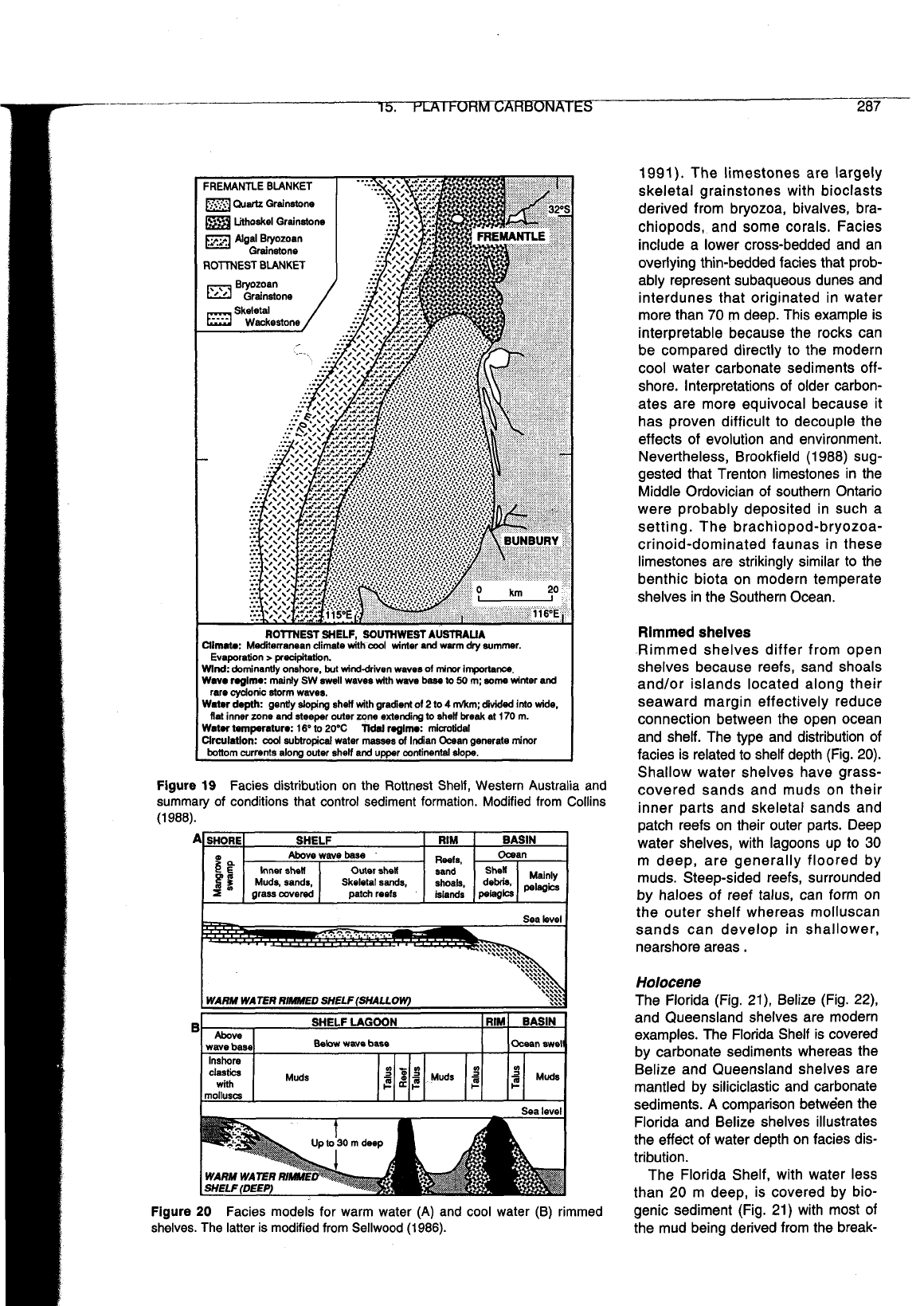
Uthoskel Grainstone
Cl1m.t.: Mediterranean dimate with cool winter and warm
dry
summer.
Evaporation
>
precipitation.
Wlnd:
dominantly onshore.
but
wind-driven waves of
mim
imporlaw.
Wave regime: mainly SW swell waves with wave
bas@
to
50 m;
mme
winter and
rare
cyclonic storm waver.
Water
depth:
gently sloping shell with gradient of 2 to
4
dm; divided into wide.
flat
inner zone and steeper outer zone extending
to
shen break at 170 m.
Water temperature: 16'lo 20°C
ndal
reglme: miuolidal
Clrculatlon: oool subtropical water masses
of
Indian Ocean generate minor
bottom currents along outer shell and upper continental dope.
1991). The limestones are largely
skeletal grainstones with bioclasts
derived from bryozoa, bivalves,
bra-
chiopods, and some corals. Facies
include a lower cross-bedded and an
overlying thin-bedded facies that prob-
ably represent subaqueous dunes and
interdunes that originated in water
more than 70 m deep. This example is
interpretable because the rocks can
be compared directly to the modern
cool water carbonate sediments off-
shore. Interpretations of older carbon-
ates are more equivocal because it
has proven difficult to decouple the
effects of evolution and environment.
Nevertheless, Brookfield
(1
988) sug-
gested that Trenton limestones in the
Middle Ordovician of southern Ontario
were probably deposited in such a
setting. The
brachiopod-bryozoa-
crinoid-dominated faunas in these
limestones are strikingly similar to the
benthic biota on modern temperate
shelves in the Southern Ocean.
Rimmed shelves
Rimmed shelves differ from open
shelves because reefs, sand shoals
and/or islands located along their
seaward margin effectively reduce
connection between the open ocean
and shelf. The type and distribution of
facies is related to shelf depth (Fig. 20).
Shallow water shelves have
grass-
Figure
19
Facies distribution on the Rottnest Shelf, Western Australia and
covered sands and muds on their
summary of conditions that control sediment formation. Modified from Collins
inner
parts
and
skeletal
sands
and
(1
988).
patch reefs on their outer parts. Deep
water shelves, with lagoons up to
30
m deep, are generally floored by
muds. Steep-sided reefs, surrounded
by haloes of reef talus, can form on
the outer shelf whereas molluscan
sands can develop in shallower,
nearshore areas.
Holocene
The Florida (Fig. 21), Belize (Fig. 22),
and Queensland shelves are modern
B
examples. The Florida Shelf is covered
by carbonate sediments whereas the
Belize and Queensland shelves are
mantled by siliciclastic and carbonate
sediments.
A
comparison between the
Florida and Belize shelves illustrates
the effect of water depth on facies dis-
tribution.
The Florida Shelf, with water less
than 20 m deep, is covered by
bio-
Figure
20
Facies models for warm water (A) and cool water
(B)
rimmed
genic sediment (Fig.
21)
with most of
shelves. The latter is modified from Sellwood
(1986).
the mud being derived from the break-
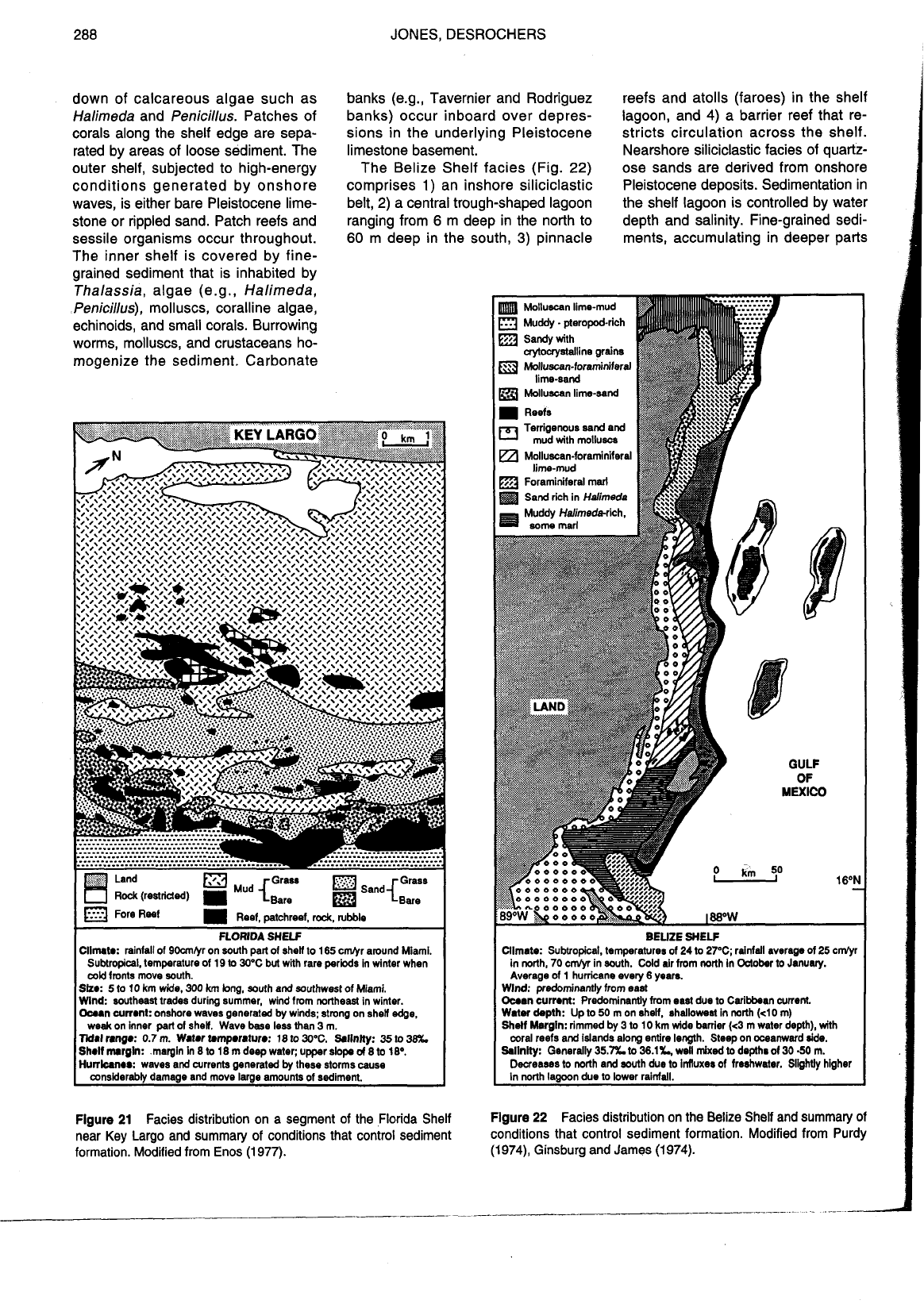
288 JONES, DESROCHERS
down of calcareous algae such as
Halimeda
and
Penicillus.
Patches of
corals along the shelf edge are sepa-
rated by areas of loose sediment. The
outer shelf, subjected to high-energy
conditions generated by onshore
waves, is either bare Pleistocene lime-
stone or rippled sand. Patch reefs and
sessile organisms occur throughout.
The inner shelf is covered by
fine-
grained sediment that is inhabited by
Thalassia,
algae (e.g.,
Halimeda,
Penicillus),
molluscs, coralline algae,
echinoids, and small corals. Burrowing
worms, molluscs, and crustaceans ho-
mogenize the sediment. Carbonate
banks
(e.g., Tavernier and Rodriguez
banks) occur inboard over depres-
sions in the underlying Pleistocene
limestone basement.
The Belize Shelf facies (Fig. 22)
comprises
1)
an inshore siliciclastic
belt, 2) a central trough-shaped lagoon
ranging from
6
m deep in the north to
60
m deep in the south,
3)
pinnacle
reefs and atolls (faroes) in the shelf
lagoon, and
4)
a barrier reef that re-
stricts circulation across the shelf.
Nearshore siliciclastic facies of
quartz-
ose sands are derived from onshore
Pleistocene deposits. Sedimentation in
the shelf lagoon is controlled by water
depth and salinity. Fine-grained sedi-
ments, accumulating in deeper parts
,
,
,
1
,
,
1
, ,
coM
fmnts move south.
Molluscan-foraminifera1
Foraminifera1 marl
Sand
rich in
Halimeda
in north,
70
cmtyr in south. Cold air fmm north In October to January.
Average of 1 hurricane every
6
years.
Wlnd:
predominantly from eant
Ocmn current: Predominantly from east due to Caribbean current.
Water
depth:
Up
to
50
m on shelf, shallowest in north
(40
m)
Shdf Mrrgln: rimmed by
3
to
10 km wide barrier
(<3
m water depth), with
coral reefs and islands along entire length. Steep on oceanward dde.
S.llnlty: Generally
35.7%.
to
36.1% well
mlxed
to
depth8 of 30 -50
m.
Decreases to north and wuth due to influxes
of
freshwater. Slightly higher
Figure
21
Facies distribution on a segment of the Florida Shelf
Figure
22
Facies distribution on the Belize Shelf and summary of
near Key Largo and summary of conditions that control sediment
conditions that control sediment formation. Modified from Purdy
formation. Modified from Enos
(1
977).
(1974), Ginsburg and James (1974).
-
--
--
--
-
-
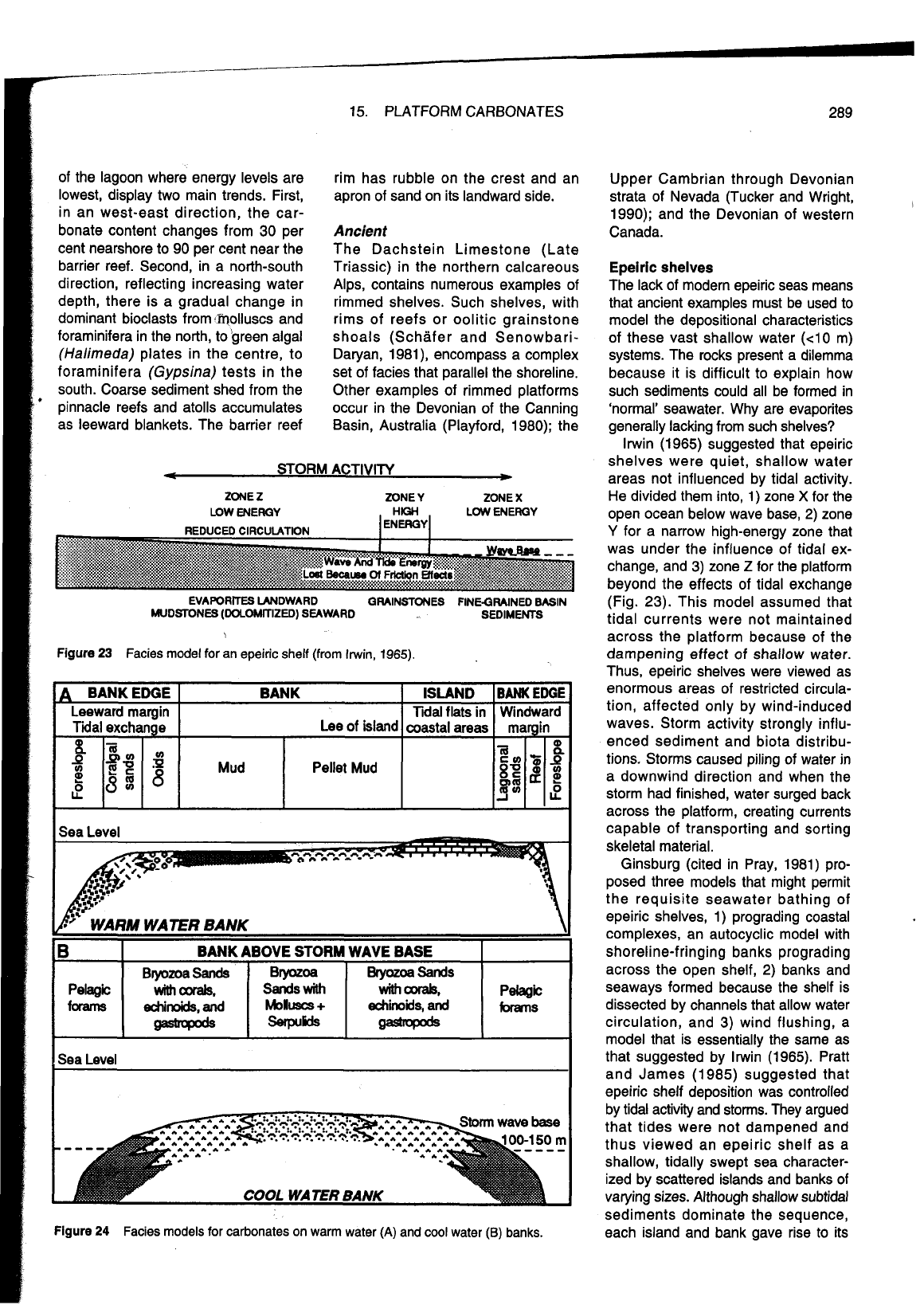
15. PLATFORM CARBONATES
of the lagoon where energy levels are
lowest, display two main trends. First,
in an west-east direction, the car-
bonate content changes from 30 per
cent nearshore to 90 per cent near the
barrier reef. Second, in a north-south
direction, reflecting increasing water
depth, there is a gradual change in
dominant bioclasts from
~~olluscs and
foraminifera in the north, to
breen algal
(Halimeda)
plates in the centre, to
foraminifera
(Gypsina)
tests in the
south. Coarse sediment shed from the
pinnacle reefs and atolls accumulates
as leeward blankets. The barrier reef
rim has rubble on the crest and an
apron of sand on its landward side.
Ancient
The Dachstein Limestone (Late
Triassic) in the northern calcareous
Alps, contains numerous examples of
rimmed shelves. Such shelves, with
rims of reefs or oolitic grainstone
shoals (Schafer and
Senowbari-
Daryan, 1981), encompass a complex
set of facies that parallel the shoreline.
Other examples of rimmed platforms
occur in the Devonian of the Canning
Basin, Australia (Playford, 1980); the
ZONE
Z
ZONE Y ZONE
X
LOW
ENERGY
,
HW
.
LOWENERGY
EVAPORES UNDWARD QRAINSTONES FlNE-GRAlNED BASIN
MUDSTONES (DOLOMITIZED) SEAWARD SEDIMENTS
Figure
23
Facies model for an epeiric shelf (from Irwin,
1965).
Figure
24
Facies models for carbonates on warm water
(A)
and cool water
(B)
banks.
Upper Cambrian through Devonian
strata of Nevada (Tucker and Wright,
1990); and the Devonian of western
Canada.
Epeiric
shelves
The lack of modern epeiric seas means
that ancient examples must be used to
model the depositional characteristics
of these vast shallow water
(40 m)
systems. The rocks present a dilemma
because it is difficult to explain how
such sediments could all be formed in
'normal' seawater. Why are evaporites
generally lacking from such shelves?
lrwin (1965) suggested that epeiric
shelves were quiet, shallow water
areas not influenced by tidal activity.
He divided them into,
1)
zone
X
for the
open ocean below wave base, 2) zone
Y
for a narrow high-energy zone that
was under the influence of tidal ex-
change, and
3)
zone
Z
for the platform
beyond the effects of tidal exchange
(Fig. 23). This model assumed that
tidal currents were not maintained
across the platform because of the
dampening effect of shallow water.
Thus, epeiric shelves were viewed as
enormous areas of restricted circula-
tion, affected only by wind-induced
waves. Storm activity strongly influ-
enced sediment and biota distribu-
tions. Storms caused piling of water in
a downwind direction and when the
storm had finished, water surged back
across the platform, creating currents
capable of transporting and sorting
skeletal material.
Ginsburg (cited in Pray, 1981) pro-
posed three models that might permit
the requisite seawater bathing of
epeiric shelves,
1)
prograding coastal
complexes, an autocyclic model with
shoreline-fringing banks prograding
across the open shelf, 2) banks and
seaways formed because the shelf is
dissected by channels that allow water
circulation, and
3)
wind flushing, a
model that is essentially the same as
that suggested by
lrwin (1965). Pratt
and James (1985) suggested that
epeiric shelf deposition was controlled
by tidal activity and storms. They argued
that tides were not dampened and
thus viewed an epeiric shelf as a
shallow, tidally swept sea character-
ized by scattered islands and banks of
varying sizes. Although shallow
subtidal
sediments dominate the sequence,
each island and bank gave rise to its
